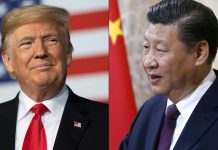Airbus Defense and Space, headquartered in Germany, has offered Seoul a “win-win strategy” to boost the sales of South Korea’s FA-50 Fighting Eagles and other fighters to Western European countries.
AGM-88 HARM: ‘Ineffective’ In Ukraine War, US Navy To Acquire Converted Anti-Radiation Missiles For Aerial Targets
The proposal was made by Michael Schoellhorn, CEO of Airbus Defense and Space, during a meeting with South Korean Industry Minister Lee Chang-yang in Seoul. Both sides are also exploring ways to strengthen collaboration in aviation, space, and other mobility industries.
The Ministry of Trade, Industry, and Energy of South Korea stated on November 16 that Airbus proposed a “win-win strategy” that would involve exporting South Korean aircraft to Western European nations.
However, neither Airbus nor South Korea specified to which nation they would particularly want to export FA-50 in western Europe.
Schoellhorn stated that Airbus would raise the volume of components it imports from South Korea from the current 700 billion won (US$529.3 million) per year to over 1 trillion won.

He raised the prospect of expanding space collaboration with South Korea. He pledged to share information about its collaborative project cases with the European Space Agency regarding South Korea’s intention to establish a space agency.
The South Korean minister welcomed selling South Korean military aircraft in Western Europe. Lee also commended the Airbus CEO for the proposal to increase imports of South Korean aviation parts and requested that the firm order new items.
Seoul has exported FA-50 to several nations. The FA-50 Fighting Eagle is developed in collaboration between Korea Aerospace Industries (KAI) and Lockheed Martin. It is a multirole fighter derivative of the ‘T-50’ line of aircraft, which includes supersonic trainers, light combat aircraft, and multirole fighters.
The aerospace sector of South Korea has grown considerably in recent years. The country recently signed a deal with Poland for the sale of 48 FA-50 FA-50 light attack aircraft, and it also successfully conducted the flight tests of the homegrown KF-21 stealth fighter jet.
Airbus To Build A R&D Facility In South Korea?
The South Korean Minister asked that Airbus establish a research and development facility in South Korea to improve collaboration in next-generation aviation industries.
Lee highlighted South Korea’s cutting-edge infrastructure and technology regarding semiconductors, displays, batteries, and software. China, India, Singapore, and Malaysia are home to Airbus’ international research and development facilities in Asia.
The ministry said that the head of Airbus clarified that his company would provide details about South Korea’s request to establish an R&D center. Lee urged to have more South Korean companies in Airbus’ aviation projects.
He suggested that more South Korean companies participate in Airbus’ aviation projects from the beginning and be considered major partners rather than just vendors.
The ministry also suggested Airbus put up specific proposals for areas where both parties could collaborate, like 3D printing and resin transfer molding. Lee promised to take deregulatory actions, tax, and other incentives to create “the world’s best investment circumstances.”
Seoul’s Growing Footprint In Europe
The East Asian nation has already established itself as a prominent weapon supplier to other countries, including Australia and India. In the past half-decade, South Korean defense companies have sold small guns and mobile howitzers to several European nations, including Turkey and Poland.
In July, Poland struck a record-breaking $5.8 billion deal with two South Korean firms. The agreement comprised 980 K2 Black Panther tanks, 672 K9 self-propelled howitzers, and 48 FA-50 fighter jets. It is believed that if all of the possibilities are activated in the coming years, the deals may be worth up to $15 billion.
In October, Poland decided to purchase 288 Chunmoo multiple rocket launchers from the South Korean company Hanwha Defense. South Korea’s defense sector has long developed weaponry and ammunition that are interoperable with American equipment. The two nations are anticipated to fight alongside each other in any battle with North Korea or China.

As a result, it is an appealing alternative for NATO members looking to rearm quickly and affordably. President Yoon Suk-yeol stated in August that his objective is to position South Korea among the top four global weapons producers, competing with the United States, Russia, and France for international deals.
According to data from the Stockholm International Peace Research Institute, the country is currently the world’s eighth-largest defense exporter, with exports increasing by 177% between 2016 and 2021.
It is said that the country will receive more orders from European countries. Late in September, the top military official from Estonia visited Seoul for the DX Korea 2022 trade show and to meet with his South Korean counterpart. South Korean company Hanwha Defense has already received an order from Estonia for 18 K9 self-propelled howitzers.
That being said, a partnership between South Korea and Airbus would be a huge step forward for the nation’s domestic military-industrial complex and might expand the country’s involvement in European defense initiatives.
- Contact the author at ashishmichel@gmail.com
- Follow EurAsian Times on Google News




